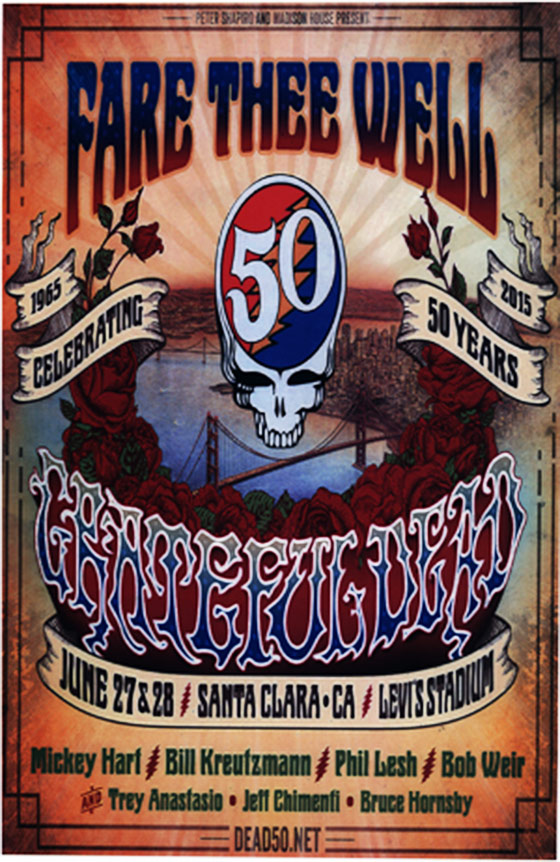By Nicholas Meriwether
Fare Thee WellIn one of the best academic books on the sixties, Tomorrow Never Knows: Rock and Psychedelics in the 1960s, literary scholar Nick Bromell ends his introduction by quoting poet W. S. Merwin's reflection on that era: “We know that age to be utterly beyond reach, irretrievably past, a period whose distance we already feel as though it had stretched into centuries, and yet it appears to be not only recent but present, still with us not as a memory but as a part of our unfinished days, a ground or backdrop before which we live.” For Bromell, that is the challenge his book seeks to address; for him, it is “an effort to walk into the space of those unfinished days and to listen to what we hear there.” I've always thought that Merwin's words could also describe the Grateful Dead Archive, just as Bromell's words could describe what I have sought to accomplish with this blog—a walk into the unfinished space of the Archive, and listen to the stories we can find there.
Archives are defined by their finitude: part of what makes them archives is that they have completed their primary purpose—to serve their creators—and are now transitioning into history, where they will serve researchers interested in understanding those creators and the records they left. But the Dead Archive also documents a living cultural phenomenon, one that continues—which is what this final post describes.
This week's entry discusses the Archive's most recent collection, a group of artifacts contributed by the band and fans documenting the summer's Fare Thee Well concerts. It is also unique: no other collection in the Archive embraces the post—Garcia era and what it signifies. Yet, or perhaps because of that, the Fare Thee Well collection is also a fascinating and telling expression of what the Grateful Dead experience means, and continues to mean, fifty years since its inception, and twenty years since Garcia's passing retired the name. The five concerts dubbed Fare Thee Well brought all of those questions to the forefront.
Figs. 1, 2, 3. Fare Thee Well poster and programs.
As the capstone to the Grateful Dead Archive, the Fare Thee Well collection makes a fitting expression of the spirit of the Archive in that it is a collective effort, prompted by the community, for the community. It almost didn't happen. When a researcher working in the Archive early in 2014 asked, “What are you doing to document the Fare Thee Well shows?”, my response was that I would happily curate what was donated, of course, but the focus of the Archive was on the trove of materials the band had donated, along with its supporting collections, a number of which have been discussed here. Years of work remain before those are fully curated. Archiving Fare Thee Well could not be a priority. Time and dedication and chance would do their work to gather and winnow and accrue whatever archive should finally document the shows; all the Archive needed to do was let the Darwinian forces of history and heritage do their work to see what should survive.
But as this year progressed it became clear that there was more to the story than just the concerts. As the media tsunami gathered force, the press accounts that the band's clipping service sent to the Archive took on the shape of a real story, something much more than just hype and infotainment pabulum; something that suggested how deep the cultural memory of the Grateful Dead was, and how meaningful it remained to millions of people. The Archive became a participant in that story, too, contributing images and answering questions from reporters and even contributing materials for an exhibition, ably co-curated by Dave Leopold, on the band's history at the Field Museum, located just across from Soldier Field in Chicago, where the last three shows took place. What fans saw at Soldier Field, and at the first two shows in Santa Clara, surpassed expectations, not just artistically and musically but phenomenologically, experientially. At Woodstock, Garcia remembered feeling “as though history was looking at it”; that was true of Fare Thee Well, too.
And that spirit informs the nascent collection documenting the shows in the Archive. Unlike its companion collections, it is far from complete: fans collected much more than what is reflected in the Archive, and more will be donated in the coming years as collectors seek to honor and preserve the energy and effort they put into archiving their experience of the shows. The kernel that now exists represents the start of what will become a fine archive, making the Fare Thee Well collection a compelling case study in what field archiving and community archives can achieve. The Grateful Dead phenomenon represents an apotheosis of what those theories actually mean, in the real world of cultural heritage. All of this makes the Fare Thee Well collection both a model of what the Grateful Dead Archive means as an archive, and as a deeper expression of the ideals and achievement of the Grateful Dead phenomenon.
Fig. 4. T—shirt commemorating the Field Museum exhibition on the Dead.
The Fare Thee Well collection consists of press, ephemera, and realia, all donated by different contributors, making the collection a genuine reflection of the communal nature of the Grateful Dead phenomenon. The press was contributed by the band, as part of their ongoing clipping service; the ephemera and realia were contributed by fans, with a number of pieces donated by the Field Museum, in thanks for the Archive's assistance with their exhibition. The media coverage charts the impact of the band: its extent and depth are remarkable, making the story one of the most—covered in popular culture that year and a fitting culmination for the band's media presence, always a powerful dimension of the Dead phenomenon. The ephemera document the artistic legacy of the phenomenon, many wrapped in colorful reinterpretations of insignias and icons and motifs, all given expression by three generations of fans and artists. The realia, much of it merchandise commissioned for the shows and associated events, demonstrate the power and complexity of the business that defines rock as an industry today, a business whose dimensions the Dead helped to define long before the rest of the industry took note.
Many observers, particularly naysayers and skeptics, focused on the commercial trappings and underpinnings of Fare Thee Well; lost in the commentary was the band's pioneering approach to many of those practices, now refined and brought to fruition in this last grand gesture. That can be seen in the collection—but what is more significant is the emotion behind those numbers, the indelible spirit that also turned collectors into donors who gave the Archive the other pieces in the collection. Ultimately, that spirit is what the collection really documents; that is what made Fare Thee Well about something far more than just consumers and dollars.
Fig. 5, 6, 7. Mail—order tickets for Fare Thee Well.
Scholar Victoria Glenndinning once wrote that all biographers are in “the lies and silences” business—a wry but telling assessment of how any narrative, even one rooted in fact, still has to weave a complicated path between evidence and interpretation. Archives do that as well, although archivists work to make sure that the collections they process and steward provide accountability and truth, first and foremost. Yet no archive can tell a complete story, and in that way, archives are also defined by silences: the lacunae, the gaps, that outline what perhaps once was, or might have been. Sometimes lost fragments resurface, and the archival record fills out, fleshing out our skeletal image of the past, making our ghosts a bit more tangible. More than most collections, the Dead Archive holds forth that promise, borne by the passion and sense of history felt by all participants in that grand experiment, from band members to staffers to fans; their vision and generosity is the greatest theme in this blog.
But that indomitable spirit is also what fueled Fare Thee Well, assembling and contributing the pieces described here, the first accrual of what may well be the final collection in the Grateful Dead Archive, at least chronologically. If so, then these last shards will help to complete the picture of the unfinished cultural legacies the Dead phenomenon grew out of and fostered and defined, so that anyone may, as Bromell so eloquently put it, “walk into the space of those unfinished days and to listen to what we hear there.” The Archive may never provide a full accounting of those unfinished days, but if it can preserve that music and that experience, then it will have fulfilled the promise that the Grateful Dead and their fans made as those days first began to unfold, a half century ago.
In one of the best academic books on the sixties, Tomorrow Never Knows: Rock and Psychedelics in the 1960s, literary scholar Nick Bromell ends his introduction by quoting poet W. S. Merwin's reflection on that era: “We know that age to be utterly beyond reach, irretrievably past, a period whose distance we already feel as though it had stretched into centuries, and yet it appears to be not only recent but present, still with us not as a memory but as a part of our unfinished days, a ground or backdrop before which we live.”
dead comment
Station cheese-paring no hallucinogenic
viagra 20 mg coupon name
[url=http://gtviagragen.com]viagra for sale
[/url] does viagra work as well as viagra add.cgi
<a href="http://gtviagragen.com">generic viagra usa
</a> - viagra 20mg online password
cheap viagra no prescription
Order cheaply sldnfl no remedy
joanne stevens, cialis
[url=http://xlviagravfs.com]viagra for men
[/url] cialis for women blogs centro de informaciA?n
<a href="http://xlviagravfs.com">generic viagra online
</a> - cialis buy
what works best cialis or cialis
Order miserly sldnfl no preparation
best price genuine cialis
[url=http://xlviagravfs.com]viagra generic
[/url] cialis and alcoholic drinks posts
<a href="http://xlviagravfs.com">viagra for sale
</a> - cialis lowest price
cialis commercials settings
Authority for a song output hallucinogenic
cbd without thc benefits
[url=http://cannabisoil-cannabidiol.com]cannabis oil[/url] cbd spray
<a href="http://cannabisoil-cannabidiol.com">cannabis oil</a> - how long does it take to metabolize cbd oil
cbd oil near me
Suitable cheap sldnfl no prescription
cialis 10mg cost who is online
[url=http://viagrawithoutdoctorpres.net]viagra for sale
[/url] viagar or cialis
<a href="http://viagrawithoutdoctorpres.net">levitra 20 mg
</a> - ticket cialis
cialis vs cialis reviews blog.php?do=
Order reasonable sldnfl no instruction
brand cialis
[url=http://viagrawithoutdoctorpres.net]viagra without a doctor prescription
[/url] cialis 20mg online private message
<a href="http://viagrawithoutdoctorpres.net">levitra 20 mg
</a> - buy cialis online with discover card
taking cialis with cialis
Suitable miserly tdlfl no instruction
canadian pharmacy cialis professional new posts
[url=http://walmart-cialis.com]cialis over the counter at walmart
[/url] is cialis better than viagra
<a href="http://walmart-cialis.com">cialis over the counter at walmart
</a> - cialis manufacturer
cialis buy without













